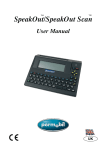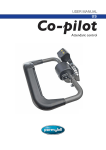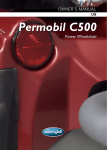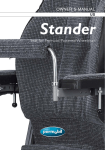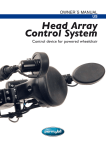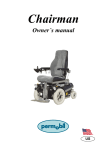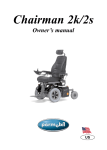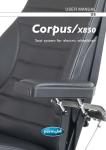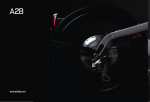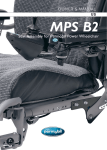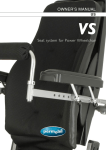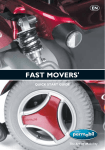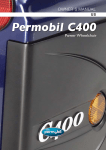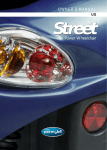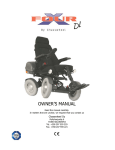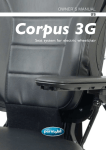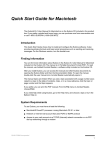Download Owner`s manual Chairman Entra
Transcript
Chairman Entra Owner’s manual US How to contact Permobil Permobil Inc. USA 6961 Eastgate Blvd. Lebanon, TN 37090 USA Phone: 800-736-0925 Fax: 800-231-3256 Head Office of the Permobil group Permobil AB Box 120, 861 23 Timrå, Sweden Tel: +46 60 59 59 00. Fax: +46 60 57 52 50 E-mail: [email protected] Chairman Entra Owner’s manual Produced and published by Permobil AB, Sweden Edition no. 3, 2002-01 Order no: 201192-US-0 PABnr: 1192:3 Owner’s Manual Chairman Entra Contents Contents Safety instructions . . . . . . . . . . . . . . . . . . . . . . . . . . . . . . . . . . . .6 General introduction . . . . . . . . . . . . . . . . . . . . . . . . . . . . . . . . . .8 Specially modified wheelchairs . . . . . . . . . . . . . . . . . . . . . . . . 8 Design and Functions . . . . . . . . . . . . . . . . . . . . . . . . . . . . . . . . .9 General . . . . . . . . . . . . . . . . . . . . . . . . . . . . . . . . . . . . . . . . .9 Seat . . . . . . . . . . . . . . . . . . . . . . . . . . . . . . . . . . . . . . . . . . . 10 Seat lift . . . . . . . . . . . . . . . . . . . . . . . . . . . . . . . . . . . . . . . . .10 Wheels . . . . . . . . . . . . . . . . . . . . . . . . . . . . . . . . . . . . . . . . .10 Reflectors . . . . . . . . . . . . . . . . . . . . . . . . . . . . . . . . . . . . . . .10 Electrical system . . . . . . . . . . . . . . . . . . . . . . . . . . . . . . . . . .11 Control panel . . . . . . . . . . . . . . . . . . . . . . . . . . . . . . . . . . . . .13 Leverman (joystick manager) . . . . . . . . . . . . . . . . . . . . . . . . .17 Seat control panel . . . . . . . . . . . . . . . . . . . . . . . . . . . . . . . . .18 Accessories . . . . . . . . . . . . . . . . . . . . . . . . . . . . . . . . . . . . . . .21 Tool bag . . . . . . . . . . . . . . . . . . . . . . . . . . . . . . . . . . . . . . . . .21 Operation . . . . . . . . . . . . . . . . . . . . . . . . . . . . . . . . . . . . . . . . .22 General . . . . . . . . . . . . . . . . . . . . . . . . . . . . . . . . . . . . . . . . .22 Driving . . . . . . . . . . . . . . . . . . . . . . . . . . . . . . . . . . . . . . . . .22 Releasing the brakes . . . . . . . . . . . . . . . . . . . . . . . . . . . . . .25 Driving rules . . . . . . . . . . . . . . . . . . . . . . . . . . . . . . . . . . . . .26 Charging the batteries . . . . . . . . . . . . . . . . . . . . . . . . . . . . . . 28 Transportation . . . . . . . . . . . . . . . . . . . . . . . . . . . . . . . . . . . . . .30 Transporting by air . . . . . . . . . . . . . . . . . . . . . . . . . . . . . . . .31 Maintenance and Repairs . . . . . . . General . . . . . . . . . . . . . . . . . . . Short-term and long-term storage Cleaning . . . . . . . . . . . . . . . . . . Wheels . . . . . . . . . . . . . . . . . . . Batteries . . . . . . . . . . . . . . . . . . . . . . . . . . . . . . . . . . . . . . . . . . . . . . . . . . . . . . . . . . . . . . . . . . . . . . . . . . . . . . . . . . . . . . . . . . . . . . . . . . . . . . . . . . . . . . . . . . . . . . . . . . . . . . . . . . . . . . . . . . . . . . . . .32 .33 .33 .34 .34 .34 Repairs . . . . . . . . . . . Changing fuses . . . Changing batteries Changing inner tube Filling with air . . . . . . . . . . . . . . . . . . . . . . . . . . . . . . . . . . . . . . . . . . . . . . . . . . . . . . . . . . . . . . . . . . . . . . . . . . . . . . . . . . . . . . . . . . . . . . . . . . . . . . . . . . . . . .35 .35 .36 .37 .37 .... .... .... ... .... . . . . . . . . . . . . . . . . . . . . . . . . . . . . . . Data . . . . . . . . . . . . . . . . . . . . . . . . . . . . . . . . . . . . . . . . . . . . . .38 Important information (only for the US market) -5- . . . . . . . . . . . . . . . . .40 Owner’s Manual Chairman Entra Safety instructions Safety instructions General A wheelchair is a motor-driven vehicle, so be very careful when using it. Incorrect use can cause a risk of injury or damage to the chair. To reduce these risks, you should read the operating instructions carefully, especially the safety instructions and warnings. Any improper modification of the wheelchair and its systems can increase the risk of accidents. Follow the recommendations in the section on Handling, in order to avoid risks when driving. All modifications to, and interference with, the key systems of the wheelchair should be done by a qualified service engineer. Always contact a qualified service engineer if you are in doubt. Warning Please show great caution where this warning symbol appears. There is a risk of personal injury. Maximum weight of user See user manual for accompanying seat. Passengers The wheelchair is not intended for carrying passengers, whatever their age. Driving Do not drive the wheelchair over edges higher than 2 1/2”. Observe caution when driving downhill, and always drive slowly. Do not drive down slopes with a gradient greater than 6°*). There is a risk that the wheelchair will not maneuver safely. Do not drive up slopes with a gradient greater than 10°. There is a risk that the wheelchair will not maneuver safely Do not drive the wheelchair where the sideways gradient is more than 10°. There is a risk of tipping over. *)Dynamic stability according to ISO 7176-2. -6- Owner’s Manual Chairman Entra Safety instructions Operating the seat lift Make sure nothing gets jammed between the chassis and the seat when you are operating the seat lift. The center of gravity is higher when the seat is raised, increasing the risk of tipping. So use the seat lift only on flat ground and not on uneven surfaces. Driving on loose or soft surfaces When the chair is set to the lowest speed, and the batteries are not fully charged, driving on certain surfaces, such as gravel, sand and thick carpets, may result in restricted movement. Releasing the brakes Make sure the wheelchair is on a level surface before you release the brakes, so it does not roll away. Charging the batteries The batteries must be charged in a well-ventilated room, not in a closet. Do not charge the batteries in a bathroom or wet room. Use only chargers with a maximum 10 A charging current (mean value). When the charger is connected, the chair must not and cannot be driven. When using acid batteries, use the acid-proof battery bag to avoid damage to the chair and adjacent surfaces. Transportation Ensure that the chair is properly secured. A chair that is not properly secured can cause serious injuries to those in the vehicle, as well as damage to the vehicle itself, if the chair comes loose. Service Only attempt the servicing and maintenance that the operating instructions say may be done by the user. All other servicing and maintenance should be done by someone with sufficient knowledge to do it correctly. Always disconnect the negative terminal of the battery before working on the electrical system of the wheelchair. Take care when using metal objects while working on the battery. A short circuit could easily cause an explosion. Always use protective gloves and glasses. The recommended air pressure is 29 psi. The tire could explode if you overinflate it. The seat is heavy, and must be handled carefully to avoid personal injuries. -7- Owner’s Manual Chairman Entra General introduction General introduction In order to get the best possible use from your wheelchair, it is important to use it in the intended way. We therefore advise you to carefully read the operating instructions, especially the safety instructions. Keep the operating instructions with the rest of the things belonging to the chair. The first thing to do is to charge the batteries. Read the chapter Charging the Batteries if you are uncertain about how to do this. Charging takes approximately 8 hours. Specially adapted wheelchair If your wheelchair is marked with a “Specially modified product” sticker, it has been modified to your specific needs and wishes. This means that the design and functions could be different from the text in these operating instructions, or the design and functions of other wheelchairs of the same type. Specifications All information and specifications given in these operating instructions were applicable when this wheelchair was delivered. As Permobil carries out continual development and improvement, we reserve the right to make changes without prior notice. -8- Owner’s Manual Chairman Entra Design and Functions Design and Functions General 1 2 3 4 6 5 1. Seat 2. Control panel 3. Chassis 4. Rear wheels 5. Drive wheels 6. Wheel bars Fig. 1. Chairman Entra with Corpus II seat -9- Owner’s Manual Chairman Entra Design and Functions Seat See Owner’s manual for accompanying seat. Seat elevator The Chairman Entra has either an electrically operated seat elevator or a fixed seat tube. Make power adjustments, of the seat elevator, through the seat control panel and vary the seat height to match your environment. If the seat elevator is raised from its lowest position, the maximum speed of the wheelchair is reduced to 2.2 mph. Because the center of gravity is higher when the seat is raised, and there is an increased the risk of tipping, use the seat lift only on level surfaces. Wheels The front wheels of the wheelchair, the drive wheels, have pneumatic tires. The double rear wheels, the castor wheels, have solid inserts. Lighting and reflectors In the standard design, the wheelchair has no lights, but is equipped with reflectors. Fig. 2. Reflectors - 10 - Owner’s Manual Chairman Entra Design and Functions Electrical system The wheelchair batteries are situated under the chassis cover, behind the electric motors. Permobil recommends that you use maintenance-free gel batteries. If you use acid batteries it is important to check the electrolyte level regularly. A battery with an electrolyte level that is too low can boil dry, resulting in increased temperature and damage to the battery. Electronic unit Batteries Fig. 3. Batteries and electronic unit When using acid batteries, use the acid-proof battery bag to avoid damage to the chair and adjacent surfaces. Fig. 4. Acid batteries should be placed in the battery bag before being placed in the wheelchair - 11 - Owner’s Manual Chairman Entra Design and Functions Drive The wheelchair has a drive unit for each drive wheel. The motors control the speed, turning and braking. A control stick on the control panel sends signals to the electronic unit under the cover at the rear of the chassis. The electronic unit is placed between the wheelchair's batteries. See fig. 3 on page 11. Drive gear Electric motor Fig. 5. Electric motor with drive gear Fuses/circuit breaker The wheelchair has a main circuit-breaker and a charge fuse. These are located below the chassis cover, near the front left wheel. 1. Main circuit-breaker, 70A 2. Charge fuse, 15A Fig. 6. Fuses/circuit-breaker - 12 - Owner’s Manual Chairman Entra Design and Functions Entra Joystick The control panel is fixed to the right-hand armrest and can be adjusted for optimum comfort during operation. The control panel can also be fitted to the left armrest. The fig. below shows the various functions of the control panel. Your wheelchair can also be equipped with a seat control panel. In that case, you can choose whether you want to control the seat functions from the seat control panel or the control panel. 4 5 6 9 7 8 A 10 B 3 2 1 C Fig. 7. Control panel 1. Selector switch 6. Lights 2. Turn signal 7. Turn signal 3. Warning light 8. Horn 4. Main switch, on/off 5. Battery voltage indicator Control panel adjustment A. Sideways adjustment Loosen the screws and adjust the control panel to the desired position. 9. Joystick B. Friction joint Adjusting screw for how light or stiff you want the sideways movement of the panel to be. 10. Seat control panel C. Length adjustment Loosen the screw and adjust the length as required. - 13 - Owner’s Manual Chairman Entra Design and Functions Security key The security key can be used to lock the wheelchair to prevent unauthorized use. To lock the wheelchair it must be switched on, the key should then be inserted into and withdrawn from the panel outlet, the wheelchair will now be locked. To unlock the wheelchair, switch it on. The maximum speed indicator will ripple up and down but driving will not be possible. The key should now be inserted into and withdrawn from the panel outlet, the wheelchair can now be driven. Panel outlet with security key Start button You use this button to start and stop the wheelchair. The start button must have been pressed for the chair to operate. Fig. 8. Start button MODE (selector) You use this switch to activate the speed selector and ”Leverman” (see page 17). Fig. 9. Mode (selector) - 14 - Owner’s Manual Chairman Entra Design and Functions Battery voltage indicator The window display on the control panel (fig.10) shows the following indicator lights (from bottom to top): Red+Yellow+Green = Fully charged Red+Yellow = Half charged Red = Charge the batteries Fig.10. Battery voltage indicator Warning symbol When you press the switch, the indicator lamps flash on the control panel for the warning symbol (red lamp) and for both indicator lights (green lamp). If your wheelchair has lights, both indicator lamps flash too, to attract attention. NB! This function works even when the start button is switched off Fig. 11. Switch warning Speed selector The speed can be set in 5 stages, and one or more of the indicator lamps light depending on which speed range has been selected. Setting speed, see page 17. 1 - 2 lamps = Low speed 3 - 4 lamps = Medium speed 5 lamps = Maximum speed Fig. 12. Speed selector - 15 - Owner’s Manual Chairman Entra Design and Functions Lights Press the switch to turn on/off the lights of the wheelchair, if so equipped. Lights Turn signals Indicators Pressing the right or left arrow activates the chair’s turn signals, if so equipped. Fig.13. Light/turn signals Warning horn Press the button to sound the horn and attract attention. Joystick The joystick is used to regulate the speed of the wheelchair forwards or backwards, to turn and to brake. The speed is regulated proportionally by moving the joystick forwards or backwards. The speed is directly proportional to the movement of the joystick (small movement low speed - large movement high speed). The wheelchair is turned by moving the joystick to the left or right. The wheelchair is braked by moving the joystick back to the neutral position or letting it go. - 16 - Fig.14. Horn switch Fig.15. Joystick Owner’s Manual Chairman Entra Design and Functions Leverman (Joystick manager) With the help of the Leverman, you can use the joystick to control the speed of the chair (5 positions), seat lift, backrest angle, seat angle and leg support. In lieu of operating the seat control panel. Operating the Leverman 1. Press the on/off button on the controlpanel to activate. Leg support active 2. Press the MODE button. The battery indicator lights and the speed selector lights flash. Step the speed range up or down by moving the joystick right or left. 3. Press MODE to move through the program. The right foot-plate lights. Now you can move the leg support out or in by moving the joystick forwards or backwards. 4. Move the joystick to the left twice and the seat lamp will come on. Moving the joystick forwards or backwards will raise or lower the height of the seat. Seat lift 5. Move the joystick to the right and both the seat and backrest lamps light. This means that seat tilt is active, and can be controlled by moving the joystick forwards or backwards. 6. Move the joystick to the right and the backrest lamp comes on. The backrest angle is stepless, and is adjusted by moving the joystick forwards or backwards. Seat angle 7. Press the MODE button again. The program ends and the chair is ready to drive. Backrest angle - 17 - Owner’s Manual Chairman Entra Design and Functions Seat control panel The seat control panel is attached between the control panel and the right armrest. The control panel and seat control panel can also be fitted to the left armrest. The fig. 16 below shows the various functions. 1. Seat lift, Fig. 16:1 The seat is raised when you press the top part of the seat lift button, and lowered when you press the bottom part of that button. 2. Backrest angle, Fig. 16:2 The backrest is angled forwards when you press the top part of the backrest angle button and backwards when you press the bottom part. 1 2 3 Fig. 16. Seat control panel 1. Seat lift 3. Seat angle, Fig. 16:3 The seat goes forwards when you press the top part of the seat angle button and backwards when you press the bottom part. You can adjust the seat continuously backwards up to maximum angle of 30°. 4. Leg support, Fig. 16:4 The leg support moves forwards when you press the top part of the leg support button and backwards when you press the bottom part. - 18 - 4 2. Backrest angle 3. Seat angle 4. Leg support Owner’s Manual Chairman Entra Design and Functions Joystick The joystick is used to regulate the speed of the wheelchair forwards or backwards, to turn and to brake. Speed The speed is regulated proportionally by moving the joystick forwards or backwards. The speed is directly proportional to the movement of the joystick. • Small movement = low speed • Large movement = high speed. Fig 17. Regulating speed - 19 - Owner’s Manual Chairman Entra Design and Functions Turning and braking The wheelchair is turned by moving the joystick to the left or right. The wheelchair is braked by moving the joystick back to the neutral position or letting it go. Fig. 18. Regulating turning - 20 - Owner’s Manual Chairman Entra Accessories Accessories We are continually developing accessories for Permobil electric wheelchairs. Contact your nearest Permobil retailer for more information about which accessories are available for your wheelchair. Tool bag A toolbar is supplied with the wheelchair, with the following tools: 4 2 3 1 5 Fig 19. Tool bag Tool Area of use 1. Protective goggles Work on the batteries 2. Hexagon keys General maintenance/adjustment of the seat 3. 13 mm open-ended spanner Changing/batteries 4. Screwdriver General maintenance 5. Seat lift crank Raising the seat - 21 - Owner’s Manual Chairman Entra Handling Handling General This wheelchair is designed for use both inside and outside. When driving inside, take normal care. Outside you must remember to drive very slowly on steep, downhill slopes and not to drive over curbs and other obstacles higher than 2.5 inches. Do not make the first test run on your own. The test run is to find out how you and the wheelchair work together and you may need some assistance. Driving 1. Switch on the wheelchair by pressing the start button on the control panel. Fig. 20. Start button - 22 - Owner’s Manual Chairman Entra Handling 2. Set a suitable speed range by first pressing the MODE button and then use the joystick to select the speed, until the desired indicator lamp comes on for your type of driving. Increase speed Reduce speed = Step to the right. = Step to the left. 1 - 2 lamps = Low speed 3 - 4 lamps = Medium speed 5 lamps = Maximum speed Fig. 21. Speed selector 3. Move the joystick carefully forwards to drive forwards, or backwards to reverse. Fig. 22. Driving forward/backwards - 23 - Owner’s Manual Chairman Entra Handling 4. The speed of the wheelchair is regulated proportionally by moving the joystick forwards or backwards to different extents. The wheelchair's electronics make it possible to move slowly over curbs and other obstacles. You can drive up to the curb or obstacle and then carefully drive over it. When you drive down an obstacle or a steep slope, you must drive slowly and brake gently. The maximum speed should be set to low speed. You can brake gently by pulling the joystick back to a position just before the neutral position. When the speed has been reduced, you can let the joystick go. NB: The wheelchair moves at reduced speed if the seat is raised. You can only drive at full speed if the seat is in its lowest position. Raising the seat lift raises the center of gravity and increases the risk of tipping. Therefore, you should only use the seat lift when driving on level ground and not on hilly, or bumby ground. Steering The wheelchair can be turned in the required direction by moving the joystick to one side or the other while driving forwards or backwards. Fig. 23. Steering - 24 - Owner’s Manual Chairman Entra Handling Releasing the brakes In order to avoid the wheelchair rolling away, ensure that the wheelchair is on a level and dry base before releasing the brakes. The brakes can be released to make it possible to move the wheelchair manually. 1. Press the start button to switch off the wheelchair. 2. Move the lever, Fig. 24, forward. The chair can now be moved manually. NB! Reset the brakes after moving the chair by pulling the lever back. When the brake release has been activated, the wheelchair cannot be driven. Check of brake release Check regularly, approx. once per month, the brake release function by engaging and disengaging the brake release a number of times. Check to see if chair actually goes in and out of freewheel by pushing the chair. Fig. 24. Releasing the brakes - 25 - Owner’s Manual Chairman Entra Handling Driving rules High edges Do not drive the wheelchair over edges higher than 2.5”. Max 2.5” Fig. 25. High edges Downward slopes When driving downhill you should drive slowly and with great care. Take extra care when driving downhill on uneven surfaces (e.g. grass, gravel, sand, ice and snow). Do not drive down slopes steeper than 6 degrees.*) *)Dynamic stability according to ISO 7176-2. Max 6° Fig. 26. Driving downhill - 26 - Owner’s Manual Chairman Entra Handling Upward slopes When driving on slopes with an angle greater than 10°, there is a risk that you won’t be able to control the wheelchair safely. Max 10° Do not drive up slopes steeper than 10 degrees. Fig. 27. Driving uphill Driving on sideways slopes Do not drive the wheelchair on sideways slopes greater than 10 degrees. There is risk of tipping. Max 10° Fig. 28. Driving on sideways slopes - 27 - Owner’s Manual Chairman Entra Handling Charging the batteries Charging should take place in a well-ventilated area, not in a wardrobe or closet. Charging should not be carried out in a bathroom or wet area. Take care when using metal objects while working on the battery. A short circuit could easily cause an explosion. Always use protective gloves and glasses. Use only chargers with a maximum 10 A charging current (mean value). (The effective value of the charging current must not exceed 12 A.) - 28 - Owner’s Manual Chairman Entra Handling When should the batteries be charged? As a general rule, you should recharge your batteries as frequently as possible to assure the longest possible life and to minimize the required charging time. Plan to recharge them when you do not anticipate using the chair for a long period of time. A battery voltage indicator on the control panel indicates when the battery voltage is low. The batteries must then be charged as soon as possible. If the batteries should become completely discharged, it is important that you recharge them as soon as possible. If you delay before recharging them, the batteries can be damaged. Charging 1. Connect the main cable to the power outlet. Turn off charger first, then, after connecting, turn on charger. 2. Connect the connection cable from the charger to the charging socket on the wheelchair, which is on the right side of the wheelchair cover. NB! When the charger is connected, the chair must not and cannot be driven. Description and Use of Battery Charger, see supplied Instruction Manual. Fig. 29 Charging socket - 29 - Owner’s Manual Chairman Entra Transportation Transportation The wheelchair can be secured with straps via the fastening loops at the front and rear. If the chair has to be transported in a van, station vagon or other vehicle, it is extremely important that the chair is secured properly and that the fastening points used are well anchored in the vehicle. If the chair is not properly secured and comes loose, it can cause serious injury to persons in the vehicle and serious damage to the vehicle and the wheelchair. Fig. 30. Front fastening loops Fig. 31. Rear fastening loops - 30 - Owner’s Manual Chairman Entra Transportation Air transport When transporting your chair by air, you should be aware of three things above all: the batteries, the dimensions and weight of the wheelchair and that the seat can be damaged when handled as it is placed together with luggage and other goods in a narrow space. Batteries If the wheelchair is equipped with maintenance-free gel batteries: in some airlines it is not necessary to remove the batteries from the wheelchair during the flight. However, the electrical connections to the battery must be disconnected and insulated. Check with your airline which rules apply. If a wheelchair is equipped with acid batteries, most airlines require that the batteries shall be removed from the wheelchair and transported in special boxes provided by the airline. Some airlines refuse to take acid batteries aboard at all, so always check with the airline in question which rules apply. See page 36 for how to remove the batteries. The dimensions and weight of the wheelchair The weight and dimensions of the wheelchair are significant in relation to the type of airplanes in which the wheelchair is to be transported. Always check with the airline in question which rules apply. Preventing damage Cover the control panel with soft, shock-absorbing material (foamed plastic or similar) and fold it in towards the back rest. Protect other salient objects in similar fashion. Tape any loose cables to the seat or covers. NB! To ensure that the chair is transported safely and that no nasty surprises pop up at the last minute, always contact the airline with which you are travelling beforehand. - 31 - Owner’s Manual Chairman Entra Maintenance and Repairs Maintenance and Repairs To ensure that your wheelchair works well, it is important that it is well looked after. Every wheelchair is subject to wear, partly between the moving parts and partly on account of strains and stresses. Therefore, you must know how the wheelchair works, how you are to drive it and use it correctly and how you are to look after it. Preventive maintenance is intended to prevent faults. If you look after your wheelchair, it will work well and the risk of faults is reduced. Any inappropriate modifications to the wheelchair and its various systems may increase risk of accidents. Carefully follow the recommendations in the Handling section to prevent the risk of accidents in connection with driving. All modifications to and interventions in the vital systems of the wheelchair must be performed by a qualified service engineer. Always contact a qualified service engineer in cases of doubt. - 32 - Owner’s Manual Chairman Entra Maintenance Maintenance During all work on the electrical system of the wheelchair, the connection to the negative pole of the battery must always be removed. Take care when using metal objects in connection with work on the batteries. Short-circuiting can easily cause an explosion. Always use protective gloves and goggles. General • Batteries discharge themselves and must be kept charged to prevent them from being damaged. • The wheelchair must not be stored in rooms in which condensation occurs (mist or moisture on surfaces), e.g. laundry or similar rooms. • The wheelchair may be stored in an unheated room. From the point of view of corrosion, it is best for the chair if the room is a few degrees warmer than the surroundings, which keeps the room drier. Short-term storage In order for the charging process to produce a battery with good capacity, the temperature in the storage room should not be less than 41 F. Storage at less than 41 F increases the risk that the battery is not fully charged when it is used and also increases the risk of corrosion. Long-term storage The chair may be stored in an unheated room but the battery should be maintenance charged at least once per month. See also Short-term storage above. - 33 - Owner’s Manual Chairman Entra Maintenance Cleaning Clean the wheelchair often. It is especially important to clean it after it has been used outside. Use a damp rag with a mild soap solution to wipe off dirt and dust. NB: Do not use a hose to wash the wheelchair with water. The electronics can be damaged. Wheels Check regularly that the air pressure in the tires is correct. Fill with air if necessary. Check of brake release Check regularly, approx. once per month, the brake release function by engaging and disengaging the brake release a number of times. Check to see if chair actually goes in and out of freewheel by pushing the chair. Batteries Storage Please note that batteries discharge of their own accord and that a discharged battery may freeze and burst when it is cold. If the wheelchair is to be stored and not used for a long period of time, the batteries must always be charged once per month to avoid damaging them. NB: The temperature in the storage room should not be less than 41 F. If your wheelchair is equipped with acid batteries, the level of acid should be checked regularly. If your wheelchair is equipped with gel batteries, there is no need to check the liquid level. The durability of the batteries depends entirely on regular charging. Fig. 32. Using battery strap - 34 - Owner’s Manual Chairman Entra Repairs Repairs Resetting the main fuse/battery cut-out The main fuse also functions as a battery cut-out but is still referred to as the main fuse in the user instruction. NB! First switch off the power on the maneuvering panel before switching the power off on the main fuse. Main fuse. You don’t normally need to change the main fuse, as you can reset it when it trips. You reset it by switching it to the "ON" position. The main circuit breaker is under the chassis cover next to the left front wheel, see fig. 33. NB! If the main fuse trips, it usually means that there is a serious electrical fault. Check the cause carefully before you reset the circuit breaker. Check the sticker to determine the on and off positions. Remove the rubber cover and move the circuit breaker in the direction shown on the sticker. NB! Replace the rubber cover. Fig. 33. Main circuitbreaker, 70A Fig. 34. Loosen the seat tube clamp. Fig. 35. Raise the seat using the seat lift crank. Charging fuse The charging fuse is next to the drive gear, see fig. 6 page 12. NB! The wheelchair should be inoperative when you change the charging fuse. - 35 - Owner’s Manual Chairman Entra Repairs Changing the batteries 1. Place the wheelchair on a level base. 2. If the chair has a fixed seat tube, loosen the screw of the seat tube clamp and use the seat lift crank to raise the seat, see fig. 34-35, page 35. If your chair has an electric seat lift, raise the seat to its highest position. 3. Switch off the main power switch. 4. Remove the chassis cover and rear cover. 5. Disconnect the battery connections. Disconnect the positive poles first and then the negative poles. Black cable from main fuse Red cable to main fuse Main fuse Front Black cable = Negative – – + Red cable = Positive + Rear Fig. 36. Battery connections 6. Lift out the batteries, using the lifting straps included. See page 35. 7. If the wheelchair has acid battery, check that the battery bag is intact. 8. Insert two new batteries.The battery poles must be facing forward. 9. Connect the battery leads, positive first and then negative. 10. Replace the chassis cover, and adjust the seat to its correct height. Tighten the seat tube clamp. 11. Charge the batteries. See Charging, on pages 28 and 29. - 36 - Owner’s Manual Chairman Entra Repairs Changing inner tubes 1. Block up the wheelchair and let out the air. 2. Pull the tyre off the wheel rim. 3. Change the punctured inner tube. 4. Replace the tyre on the wheel rim and fill with air. Fig. 37. Filling valve Filling with air The recommended air pressure is 29 psi. Overfilling entails the risk of explosion. Low air pressure in the tyres produces abnormal wear and reduces the range. Therefore, check regularly that the front tyres have a pressure of 29 psi. 1. Unscrew and remove the plastic caps on the air valves on the drive wheels. 2. Connect the compressed air nozzle to the air valve and adjust the tyre pressure to the prescribed level. - 37 - Owner’s Manual Chairman Entra Technical specifications Data General Name ..................................................Chairman Entra Size and weight MPS B seat Length..................................................40 inches Width....................................................25 inches Seat heigth ..........................................21 inches Weight, incl. batteries ..........................220 lbs Maximum weight of user ....................224 lbs Wheels Wheel size, front..................................2.50 x 8 Air pressure in front wheels ................29 psi Wheel size, rear ..................................200 x 50 Performance Range ..................................................18-22 miles Max. speed, forwards ..........................4 mph Max. speed, backwards ......................approx. 2 mph Turning circle, 180 degrees ................43 inches Ability to negotiate obstacles ..............2.5 inches Hill climbing ability, downward slope ..6 degrees*) Hill climbing ability, upward slope........10 degrees *Dynamic stability according to ISO 7176-2. Electrical system Electronics PM80 Pilot+ Control panel JSM-L 7key Pilot+ Batteries Recommended battery type ................ Gel Battery capacity ................................... 2 x 73Ah Charging time ...................................... 8 hours. Fuses and circuit breakers Charging fuse ...................................... 15A Main circuit breaker ............................. 70A - 38 - Corpus II seat 40 inches 25 inches 21 inches 318 lbs 224 lbs Owner’s Manual Chairman Entra Notes - 39 - Owner’s Manual Chairman Entra Important Information CAUTION! It is very important that you read this information regarding the possible effects of electromagnetic interference on your powered wheelchair. Electromagnetic Interference (EMI) From Radio Wave Sources Powered wheelchairs and motorized scooters (in this text, both will be referred to as powered wheelchairs) may be susceptible to electromagnetic interference (EMI), which is interfering electromagnetic energy (EM) emitted from sources such as radio stations, TV stations, amateur radio (HAM) transmitters, twoway radios, and cellular phones. The interference (from radio wave sources) can cause the powered wheelchair to release its brakes, move by itself, or move in unintended directions. It can also permanently damage the powered wheelchair’s control system. The intensity of the interfering EM energy can be measured in volts per meter (V/m). Each powered wheelchair can resist EMI up to a certain intensity. This is called its ”immunity level”. The higher the immunity level, the greater the protection. At this time, requested immunity level as per EN 60601-1-2 is 3 V/m. The immunity level of this powered wheelchair model as shipped, with no further modification, is >20V/m in the range of 26 MHz to 950 MHz. There are a number of sources of relatively intense electromagnetic fields in the everyday environment. Some of these sources are obvious and easy to avoid. Others are not apparent and exposure is unavoidable. However, we believe that by following the warnings listed below, your risk to EMI will be minimized. The sources of radiated EMI can be broadly classified into three types: 1. Hand-held portable transceivers (transmitters-receivers) with the antenna mounted directly on the transmitting unit. Examples includes: citizens band (CB) radios, ”walkie talkie”, security, fire, and police transceivers, cellular telephones, and other personal communication devices. NOTE! Some cellular telephones and similar devices transmit signals while they are ON, even when not being used. 2. Medium-range mobile transceivers, such as those used in police cars, fire trucks, ambulances, and taxis. These usually have the antenna mounted on the outside of the vehicle. - 40 - Owner’s Manual Chairman Entra Important Information 3. Long-range transmitters and transceivers, such as commercial broadcast transmitter (radio and TV broadcast antenna tower) and amateur (HAM) radios. NOTE! Other types of hand-held devices, such as cordless phones, laptop computers, AM/FM radios, TV sets, CD players, and casette players, and small appliances, such as electric shavers and hair dryers, so far we know, are not likely to cause EMI problems to your powered wheelchair. Because EM energy rapidly becomes more intense as one moves closer to the transmitting antenna (source), the EM fields from hand-held radio wave sources (transceivers) are of special concern. It is possible to unintentionally bring high levels of EM energy very close to the powered wheelchair’s control system while using these devices. This can affect powered wheelchair movement and braking. Therefore, the warnings listed below are recommended to prevent possible interference with the control system of the powered wheelchair. WARNINGS Electromagnetic interference (EMI) from sources such as radio and TV stations, amateur radio (HAM) transmitters, two-way radios, and cellular phones can affect powered wheelchairs and motorized scooters. Following the warnings listed below should reduced the chance of unintended brake release or powered wheelchair movement which could result in serious injury. 1. Do not operate hand-held transceivers (transmitters/receivers), such as citizens band (CB) radios, or turn ON personal communications devices, such as cellular phones, while the powered wheelchair is turned ON. 2. Be aware of nearby transmitters, such as radio or TV stations, and try to avoid coming close to them. 3. If unintended movement or brake release occurs, turn the powered wheelchair OFF as soon as it is safe. 4. Be aware that adding accessories or components, or modifying the powered wheelchair, may make it more susceptible to EMI. (Note: There is no easy way to evaluate their effect on the overall immunity of the powered wheelchair). 5. Report all incidents of unintended movement or brake release to the powered wheelchair manufacturer, and note whether there is a radio wave source nearby. - 41 -












































